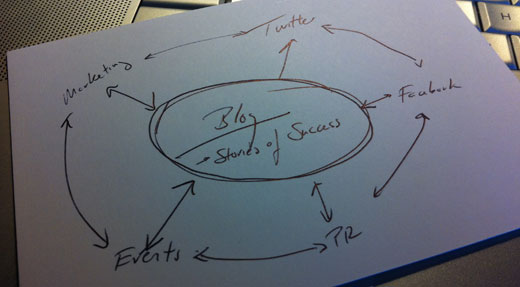Telling Stories for Social Success
I had a recent chat with a large philanthropic organization about their social media usage, successes, and challenges. They hired someone over a year ago to help manage their social strategy and now they were trying to measure success and justify positions and commitment. As we chatted, I was listening to their metric for success…it was centered around the number of dollars raised and how this “perceived” social awareness has driven individuals to give.
This conversation really had me thinking about ways we could re-tool and rethink the approach. They were using mainstream approached to social awareness with outlets like Twitter, Facebook…using these outlets to promote events and build connections. But the more and more I looked at what they were doing…I had no idea what their story was all about. I had to search and understand why I should “Follow” the conversations, why I should be a “Friend.” I was not even sure who I was talking to, a brand, a person, a large entity.
So I challenged them to start telling stories, case studies of how these philanthropic dollars help the individuals. I would not find stories of success in their digital space, stories that justify the dollars being spent on research The research that helps people. So…I started drawing!
Social Media does not raise the money. Social Media and online tools are just tools of credibility and connection. Yes…we can connect online and build virtual relationships, but giving hard earned money happens because of a relationships, some due diligence, and checking the facts. Checking the facts, the credibility piece, is where the Social Story is so important.
When I meet someone who is talking about giving to a foundation, an event, or idea…it is through a relationship. A real person. We meet, we chat, then I learn more about the cause. Afterwards, I go home and sit down and start searching online. I begin to read websites, get on chats, follow people on Twitter that share those interests. I begin to build online relationships as a part of this credibility search. This is where the social space is such a great tool, it is the PR/Marketing tool that puts information and people at the fingertips of those who are searching to make a decision.
Telling stories works and it works well. So how can we tell stories in the digital space so when people are searching for information, it is readily available? Well…it starts with the mothership. You have to have a mothership that is the digital home for all the stories. This is the place where all digital, web traffic will go for the audiences to enjoy. This mothership has to be dynamic, meaning it has to have recent information and continually updated.
In this situation, I would start three processes:
1) Start A Blog – The purpose here is to tell rich success stories in the organization. Write a new story once a week, one that touches the heart of the cause. Once a week, find a new success story and describe what makes it so special. Let it be passionate, let it be rich with ups and downs. Let the textual words of these stories grab at the hearts of the readers.
2) Video Record Stories – Use a flip camera, iPhone, some digital video device to capture tiny moments in time that show the life of the story. Is it the moment that a person has been cured of a disease, or did they get to go home from the hospital, did a child get a toy, something that visually represents emotion…the moment in time that grabs the emotion of the event. Put these stories on a YouTube channel, then embed them in the blog posts.
3) Take Lots Of Pictures – Use a digital camera to show pictures, images of the stories. Show happy and sad faces, struggles, excitement, emotion. Use visuals to paint the picture of the story. Put these images on a Flickr account and embed them in the blog.
All three of these things are centralized on the blog, showcasing passionate stories of the philanthropic organization. Spend months writing, recording, and capturing these stories. Each time you capture a new story, share it with your friends on your social outlets. Do more that just post links to the stories, but tell us why this story meant so much to you to share. You have to be just as passionate in your sharing as you are in your writing of the post.
Over time, you are building a library of stories, case-studies. These can begin to become focal points of your PR/Marketing exercises. Sharing the stories as campaigns. Imagine billboards, tv spots, brochures being created around these stories of success. All driving traffic back to the blog where people can read more. Imagine your PR campaign, sharing these stories with media outlets, enticing them to come write about the stories for their audiences. It all starts with stories and putting them in one spot. Build a library of stories over time.


